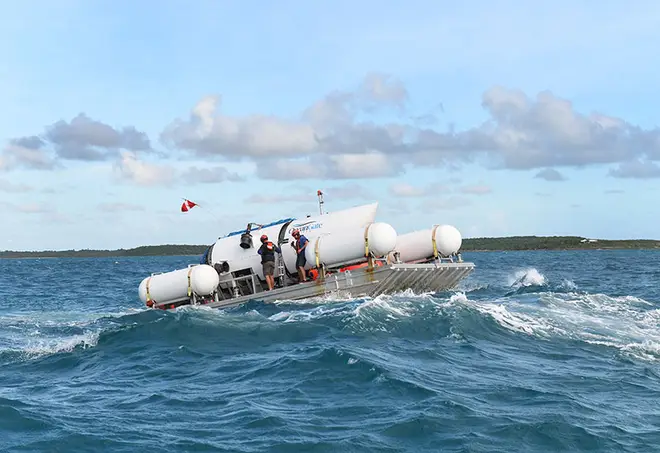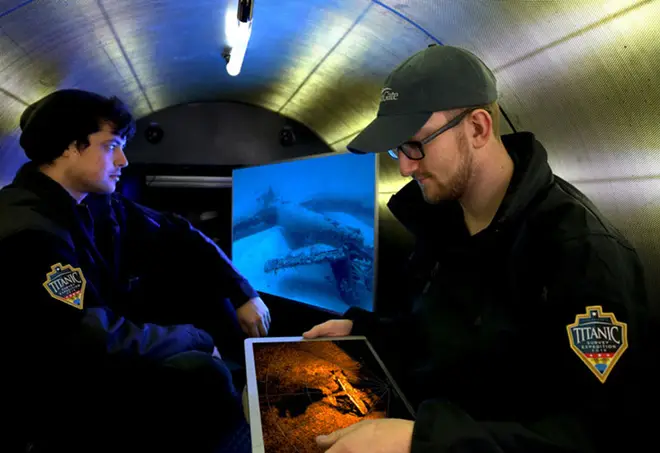
Shelagh Fogarty 1pm - 4pm
21 June 2023, 09:02

Rescuers are desperately hunting for the missing Titan submersible that vanished while on a trip down to the depths of the Atlantic Ocean to visit the wreck of the Titanic.
The 6.7 metre long carbon fibre and titanium tube, which has five people aboard, has been missing since Sunday. Officials say they have enough oxygen to last until Thursday morning at 11am UK time.
People hunting for the Titan heard a banging sound on sonar that they believe might have been made by the passengers - but attempts to find them based on this came to nothing.
It has emerged that private US company OceanGate, which operates and built the Titan, has been warned by experts about the possible "catastrophic" results of its "experimental" methods. The submersible is built with off-the-shelf components, and is steered with a PlayStation controller. The ship also lost contact with controllers on a trip last year.
Here's a breakdown of what we know about the rescue effort, the passengers onboard the Titan, and the conditions inside.

On Tuesday, Captain Jamie Frederick of the US Coast Guard said a "unified command" of multiple agencies had been formed to tackle the "very complex problem" of finding Titan.
He told a press conference in Boston there were "approximately 40/41 hours" of breathable air, of the vessel's reported 96-hour oxygen supply, left on board.
He said: "On Sunday, the co-ordination command centre in Boston received a report from the Canadian expedition vessel Polar Prince of an overdue submarine, Titan, with five people on board.
"The Titan was attempting to dive on the wreck of the Titanic, approximately 900 miles east of Cape Cod and 400 miles south of St John's, Newfoundland.
"Approximately one hour and 45 minutes into the scheduled dive, the Polar Prince lost all communication with the Titan, Polar Prince conducted an initial search and then requested Coast Guard assistance.

"The US Coast Guard in Boston assumed the responsibility of search-and-rescue mission co-ordinator and immediately launched search assets.
"Since Sunday, the Coast Guard has co-ordinated search efforts with the US and Canadian Coast Guard, Air National Guard aircraft and the Polar Prince, which has searched a combined 7,600 square miles, an area larger than the state of Connecticut."
He said these efforts have involved aircraft searching by sight and with radar and sonar buoys, and that on Tuesday Deep Energy, a 194-metre pipe-laying vessel, with "underwater ROV (remotely operated vehicle) capability" had joined the search.
He added: "They have rendezvoused with the vessel Polar Prince, and commenced an ROV dive at the last known position of the Titan and the approximate position of the Titanic wreck. That operation is currently ongoing."

Captain Frederick said several private research vessels with "ROV capabilities are making preparations to join the efforts".
But he was non-committal when asked if there is any way to retrieve the submersible and save the five on board if it can be located.
"So, right now all of our efforts are focused on finding the sub," he said.
"What I will tell you is we have a group of our nation's best experts in the unified command and if we get to that point, those experts will be looking at what the next course of action is."

Rescuers are in a race against time to find British billionaire Hamish Harding and four other passengers on board the 6.7 metres (22ft) long OceanGate Expeditions vessel.
They are UK-based businessman Shahzada Dawood and his son Suleman, reportedly together with French submersible pilot Paul-Henry Nargeolet.
On Tuesday, OceanGate confirmed that its chief executive and founder Stockton Rush "is aboard the submersible as a member of the crew".
Shahzada Dawood is a longtime supporter of The Prince's Trust International and The British Asian Trust, both of which are charities founded by the King.
It is understood that Charles has asked to be kept fully up to date on the situation and that his thoughts and prayers are with the Dawood family and all those involved.

On social media at the weekend, Mr Harding said he was "proud to finally announce" he would be aboard the mission to the wreck of the Titanic.
But he added that due to the "worst winter in Newfoundland in 40 years, this mission is likely to be the first and only manned mission to the Titanic in 2023".
He continued: "A weather window has just opened up and we are going to attempt a dive tomorrow.
"We started steaming from St John's, Newfoundland, Canada yesterday and are planning to start dive operations around 4am tomorrow morning.
"Until then we have a lot of preparations and briefings to do."

Mr Harding holds three Guinness World Records, for longest duration and distance traversed at full ocean depth by a crewed vessel, and fastest circumnavigation via both poles by aeroplane.
Two of these feats were achieved by Mr Harding and fellow explorer Victor Vescovo when they dived to the lowest depth of the Mariana Trench - the deepest part of the ocean - in a two-person submergence vehicle in March 2021.
In July 2019, Mr Harding was part of a team that achieved the fastest circumnavigation of Earth via both geographic poles by plane with a time of 46 hours, 40 minutes and 22 seconds.
In June 2022 he went into space on Blue Origin's New Shepard rocket.
His cousin, Kathleen Cosnett, told The Daily Telegraph she saw Mr Harding as "daring" and "inquisitive", and that she was "devastated" to learn he was missing.

Mr Dawood and his son have been named as two of the other people on the submersible by their family.
A Dawood family statement obtained by CNN said: "As of now, contact has been lost with their submersible craft and there is limited information available.
"We are very grateful for the concern being shown by our colleagues and friends and would like to request everyone to pray for their safety while granting the family privacy at this time.
"The family is well looked after and are praying to Allah for the safe return of their family members."
Mr Dawood is the vice chairman of Pakistani conglomerate Engro Corporation, which was founded as a fertiliser business, and according to the company's website, he is a board member of Prince's Trust International.
It is understood the Dawood family, who live in Surbiton, south-west London, are in Canada for a month.

The submersible, a Cyclops-2 model named Titan, is the second Cyclops model built by OceanGate, after the Cyclops-1.
As there are no doors on the craft, passengers begin their journey by climbing in through an entry hatch which is then bolted shut from the outside before they descend 13,000ft (2.4 miles) beneath the ocean surface to the Titanic, Mail Online reported.
There are no seats on the 22ft long, 9.5ft wide and 9.2ft high cylindrical craft, meaning passengers must sit on the hard floor without shoes, which they are required to leave behind.
If they need the toilet, they must use a small black box separated by a curtain from the rest of the crew.
Cut off from communication with the outside world, they have no idea whether they will ever be found.
There are no windows except a small porthole directly next to the toilet at the front of the craft, which is also the primary viewpoint to look out at the Titanic.
When the craft was still operational, the pilot used a modified Logitech games controller to steer it.

Even if rescuers locate the craft before its oxygen supply runs out, the occupants face other dangers.
One possibility is that they are stranded at the bottom of the ocean near the site of the Titanic, about 370 miles off the coast of Newfoundland, Canada.
If that is the case, those on board will be faced with a rapidly dropping temperature which puts them at risk of hypothermia.
Rescuers are in a "race against time" to reach the vessel before the oxygen runs out, which is expected to happen on Thursday.
David Gallo, a senior adviser for Strategic Initiatives for RMS Titanic, told CNN that temperatures on the ocean floor are "just above freezing cold".
He said: "It is a race against time - you are fighting oxygen levels, also fighting the cold if the sub is still at the bottom, because the deep ocean is just above freezing, so hypothermia is an issue.
"The water is very deep - two miles plus. It's like a visit to another planet, it's not what people think it is. It is a sunless, cold environment and high pressure."

According to oceanologist Dr Simon Boxall of the University of Southampton, one common misconception is that people will get decompression sickness, commonly nicknamed "the bends", if the boat moves up to the surface too quickly.
He told PA that those on board would not suffer "ill-effects" because the boat is at atmospheric pressure.
He also said it is a mistake to believe passengers could use escape hatches, because if they did they would be crushed.
He added, on GB News, that the boat is not above the surface because if this was the case crews would be able to use radios.

Dr Boxall said a distress signal from the submarine has been sent out.
He told PA: "This is second-hand knowledge but my understanding is that they have received a signal from the submarine.
"You can't use radios underwater.
"You rely totally on 'pings'. What they have is really limited communication.
"Apparently they have had, and I don't know when, they have had an emergency ping saying the vessel is in distress.
"I don't know if that is automatically generated or generated by people on board.
"It could be that the vessel is lost already or it could be automatic."
He said he did not know when the message was transmitted.